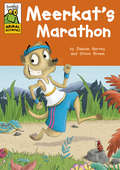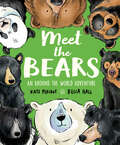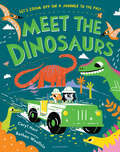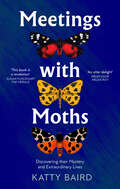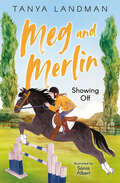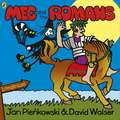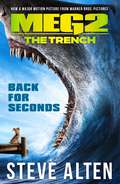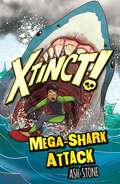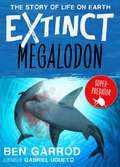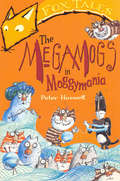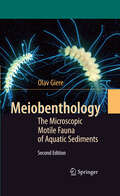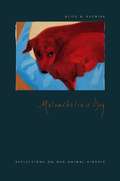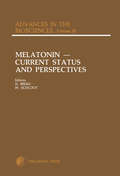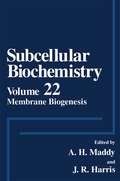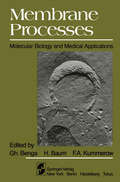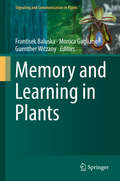- Table View
- List View
Meerkats (Nature's Children Ser.)
by Tim HarrisWhere do meerkats live? What do meerkats eat? How big are meerkats? Find out the answers to these questions and learn all about the physical characteristics, behavior, and habitats of meerkats.
Meerkat's Marathon (Froglets: Animal Olympics #3)
by Damian HarveyMeerkat is taking part in the longest running race - the marathon! He is so small, how will he complete such a big race? He soon realises he'll need some help!The Froglets series is perfect for children who are reading on their own, with fun stories of no more than 200 words. They are suitable for 5 year olds or those reading book band 5.
Meet The Bears (Meet The…)
by Kate PeridotPack your teddy and your bear-proof lunchbox and join us on a thrilling international adventure to meet the world's eight species of bears. From polar bears to giant pandas, from spectacled bears to the asiatic moon bears, find out what makes bears so amazing. But what sort of bear is your teddy?Includes a map of the world showing bear hotspots and a bear size comparison spread.
Meet the Dinosaurs (Meet the . . .)
by Caryl HartZOOOOM! We're off on an exciting journey into the past to meet the amazing dinosaurs that once roamed the earth. Join in with the rhymes and get ready to spot all the friendly (and not so friendly!) dinosaurs, from the huge Brontosaurus and amazing Diplodocus to the speedy Velociraptor and scary T-Rex. Little ones will have an action-packed time (and be back in time for bed!) in this fun and fact-packed picture book. This bold, bright follow-up to the acclaimed picture books Meet the Planets, Meet the Oceans and Meet the Weather is filled with ALL your favourite dinos. Combining STEM learning with a rhyming twist, it's perfect for all would-be palaeontologists.
Meet the Gang (Early Reader)
by Francesca SimonEarly Readers are stepping stones from picture books to reading books. A blue Early Reader is perfect for sharing and reading together. A red Early Reader is the next step on your reading journey.When Honey the puppy comes to live on Buffin Street, everyone is very excited. And Honey is about to discover just how much fun Buffin Street can be!
Meetings with Moths: Discovering Their Mystery And Extraordinary Lives
by Katty BairdMossy greens, conker browns, cream, chocolate and deepest black; add stripes, swirls and splotches and you have some of the most striking wildlife Britain has to offer.
Meg and Merlin: Showing Off (Meg and Merlin #2)
by Tanya LandmanA new friend helps Meg to realise that appearances aren’t always what they seem in this exciting new addition to Tanya Landman’s delightful horse-riding series.
Meg and the Romans
by Jan PienkowskiMeg and Mog meet a new friend - a Roman who is in need of help! But will Meg's spell get him to London? Find out in this colourful new adventure and find out more about what Romans were really like...The Meg and Mog books have been entertaining children for nearly forty-five years; with their vibrant and unique artwork - they are perfect for sharing together, reading alone, and exploring the colours, shapes and characters in the pictures.
MEG: The Trench (Megalodon #2)
by Steve AltenThey thought it was over. But it's only just beginning. For the first time, the captive 20-ton Megalodon shark has tasted human blood, and it wants more...Four years after the incident at the Mariana Trench that unleashed a pregnant Megalodon, Meg, the giant prehistoric great white shark, is dead, and Jonas Taylor now houses her one surviving offspring at the Tanaka Institute.But Meg's spawn is now grown to a monstrous size – and she's ready to breed...Deeply in debt, Taylor has turned to an eccentric billionaire to help keep the institute afloat, but it doesn't come without a price. Drawn into a web of deceit and lies, plagued by nightmares of his own death, Taylor must once again face frightening monsters of unimaginable power.And this time, it's not just the sharks he has to watch out for...'Two words: Jurassic shark... that is all you need to know.' LA Times
Mega-Shark Attack: Book 3 (Xtinct! #3)
by Ash StoneA Megaladon Shark comes back to life in this action-packed adventure story. When Jeevan gets caught in one of Barron Fox's fishing nets, he is pulled into a dangerous underwater adventure. But drowning is the least of his worries. An extinct animal has come back to life in the water ... a megaladon shark! Can Jeevan escape the jaws of the mega-shark and outwit Barron Fox's hunters?Perfect for fans of Beast Quest, Deadly 60 and Jurassic Park, these action-packed adventures will inspire readers to help save endangered species and combat extinction.
Megalodon (Extinct the Story of Life on Earth #6)
by Ben GarrodTV scientist Ben Garrod presents the biggest extinction events ever, told from the point of view of evolution's superstars, the most incredible animals ever to swim, stalk, slither or walk our planet. Whether you're 9 or 90, his unique exploration of the most destructive, yet most creative, force in nature makes top level science fun. Here are the superstars of the story of life, from the super-weird to the super-ferocious. Usually a species has 10 million years or so of evolving, eating, chasing, playing, maybe doing homework, or even going to the moon before it goes extinct.Megalodon, the super-predator, had the most powerful bite force ever measured! Terrorising the oceans, it hunted with stealth and skill, but even Megalodon died out, along with 50 percent of marine mammals, 2.5 million years ago. Find out why!Collect all eight books about animals we have lost in mass extinctions caused by asteroids or mega-volcanoes, clashing continents and climate change.Also includes: * Past brought to full-colour life by palaeoartist Gabriel Ugueto * Ask an Expert contributions from leading scientists * Glossary and pronunciation guide
The Megamogs In Moggymania
by Peter HaswellWatch out! The mighty moggies are here to make mischief and mayhem!The Megamogs think of a clever plan to see off a nasty group of dogs. Glitzy leaves the gang to lead a glamorous new life. Then Miss Marbletop and Tracy have a scary adventure in Scotland. Three linked stories - ideal for builging reading confidence.
Mein Ich, die anderen und wir: Die Psychologie der Persönlichkeit und die Kunst des Wohlbefindens
by Brian LittleWelchen Einfluss hat unsere Persönlichkeit auf unser Leben? Und wie, wenn überhaupt, können wir sie verändern? Dieses Buch zu lesen ist wie eine Einführungsvorlesung eines charmanten, geistreichen und bewunderten Professors zur Persönlichkeitspsychologie … Mein Ich, die anderen und wir zeigt uns die Universalien und die Spezifika, also die Verhaltensmerkmale, die in der gesamten Menschheit zu finden sind, und die einzigartigen Erfahrungen, die unser „Selbst“ schaffen … Am Ende wendet sich Brian Littles Buch der „Kunst“ des Wohlbefindens zu: der Bedeutung von Projekten, die uns Motivation und Sinn verschaffen. Wir alle stehen, so sein Hinweis, in unseren vielfach facettierten Leben vor der Herausforderung, „uns mit uns selbst zu versöhnen“ wie auch mit den Menschen, die bedeutsam für unser Leben sind – der perfekte Schlussakkord für eine Vorlesung wie für ein Buch wie für ein Leben. The Wall Street Journal Mein Ich, die anderen und wir ist dann besonders aufschlussreich, wenn Little über die polarisierenden Kategorien hinausgeht und zum Beispiel die Auswirkungen unserer Persönlichkeiten auf das erkundet, was er unsere „persönlichen Projekte“ nennt. New York Times Book Review Brian Little ist einer der klügsten, lustigsten, freundlichsten und gebildetsten Menschen, denen ich je begegnet bin, und in diesem Buch bekommen Sie eine großzügige Portion aller dieser Persönlichkeitsmerkmale serviert. Ein überaus wichtiges Buch für jeden, der seine Kollegen, seine Lieben – und sich selbst – verstehen will. Susan Cain, Autorin des New York Times-Bestsellers Still. Die Kraft der Introvertierten _____ Sind Sie zum Glücklichsein geboren – oder zur Verdrießlichkeit veranlagt? Glauben Sie, Ihre Zukunft in der Hand zu haben, oder überlassen Sie sich eher den Strömungen des Schicksals? Stellen Sie sich vor, es wäre Ihnen egal, was andere Leute über Sie denken – wären Sie dann glücklicher oder einfach weniger fähig, sich in die Gesellschaft einzugliedern? Und ist die cholerische „Typ-A“-Person, mit der Sie zusammenleben, zum baldigen Herzinfarkt verdammt, oder treibt sie nur Sie in den Wahnsinn? Die wissenschaftlichen Forschungen der letzten Jahrzehnte haben manche alten Vorstellungen von der Natur der menschlichen Persönlichkeit in ein neues Licht gerückt. So stellten Neurowissenschaftler, Biologen und Psychologen die Theorien von Freud und Jung sowie die Vorstellungen der Humanistischen Psychologie aus den 1960er-Jahren auf den Prüfstand. Man verwarf die allzu simplen Kategorisierungen in „Persönlichkeitstypen“ und entwickelte neue Instrumente und Verfahren, um zu ergründen, wer wir sind. Brian R. Little, renommierter Professor und Pionier der psychologischen Forschung, zählt zu den Wegbereitern dieser neuen Wissenschaft. In seinem klugen und geistreichen Buch präsentiert er eine Fülle neuer Daten und provokanter Einsichten zu der Frage, wer wir sind, warum wir uns so verhalten, wie wir es tun, was wir an unserer Persönlichkeit ändern können – und was nicht – und wie wir uns am besten unserer „Natur“ gemäß entfalten. Mein Ich, die anderen und wir erörtert Fragen, die tief im menschlichen Bewusstsein verwurzelt und zugleich so alltäglich sind wie eine Unterhaltung am Frühstückstisch – etwa ob unsere Persönlichkeitsmerkmale mit dreißig Jahren „zementiert“ sind oder ob sich das Gehirn und unser Selbst auch dann noch formen lassen. Das Buch widmet sich auch der Frage, welche Bedeutung unsere Persönlichkeit für Gesundheit und Erfolg hat und inwiefern unser Wohlbefinden von den persönlichen Projekten abhängt, die wir verfolgen. Mit Geschichten, Studien, persönlichen Erfahrungen und unterhaltsamen interaktiven Tests vermittelt Mein Ich, die anderen und wir ein lebendiges, zum Nachdenken anregendes und letztlich optimistisches Bild von den Chancen und Gefahren, die es birgt, ganz und gar wir selbst zu sein, während es zugleich die Persönlichkeiten jener vertrauten
Meiobenthology: The Microscopic Motile Fauna of Aquatic Sediments
by Olav GiereMeiobenthology is the science of the tiny animals that live in huge numbers in all aquatic sediments. This fully revised and enlarged second edition emphasizes new discoveries and developments in this field. Major progress has been made in three general areas: - Systematics, diversity and distribution, - Ecology, food webs, and energy flow, - Environmental aspects, including studies of anthropogenic impacts. The meiobenthos of polar and tropical regions, deep-sea bottoms and hydrothermal vents are now studied in more detail. The high number of species found to survive under such extreme conditions puts them at the forefront of biodiversity studies. Molecular screening methods enable large numbers to be analyzed upon applying reasonable effort. The aim of this book is to synthesize these modern scientific achievements such that meiobenthology can play a key role in aquatic research and in assessing the health of our environment.
Meiotic Configurations: A Source of Information for Estimating Genetic Parameters (Monographs on Theoretical and Applied Genetics #1)
by J. SybengaThe aim of the monographs is to foster effective intra- and interdisciplinary communication between geneticists, and plant and animal breeders. This is to be achieved by publishing authoritative up-to-date texts; concise, but at the same time comprehensive, monographs, and multiauthor volumes on theoretical and applied genetics. The following broad fields of genetics and breeding are within the scope of the series: Evolutionary genetics Developmental genetics Population genetics Biochemical genetics Ecological genetics Somatic cell genetics Biometrical genetics Agricultural genetics Cytogenetics Mutation breeding Radiation genetics Breeding methodology Acceptable subjects for the Monographs on Theoretical and Applied Genetics are basic and applied aspects of genetic variation; genetic resources; genetic exchange and reproduction; mutagenesis; genotype-environment interaction; gene structure, regulation, action, expression and interaction; chromosomal and extrachromosomal inheritance of economic traits, and genetic models and simulations. September 1975 The Editors Preface Meiotic configurations are looked at from a special point of view in this book: the extraction from them of the maximal amount of quantitative information of genetic interest. Although this requires a certain understanding of their origin and consequences, much of what is known about chromosomes and their for mation into the special structures collected under the rather indiscriminate term I "configuration", is not considered relevant for this purpose, and simply neglected.
Melancholia's Dog: Reflections on Our Animal Kinship
by Alice A. KuzniarBred to provide human companionship, dogs eclipse all other species when it comes to reading the body language of people. Dog owners hunger for a complete rapport with their pets; in the dog the fantasy of empathetic resonance finds its ideal. But cross-species communication is never easy. Dog love can be a precious but melancholy thing. An attempt to understand human attachment to the canis familiaris in terms of reciprocity and empathy, Melancholia’sDog tackles such difficult concepts as intimacy and kinship with dogs, the shame associated with identification with their suffering, and the reasons for the profound mourning over their deaths. In addition to philosophy and psychoanalysis, Alice A. Kuzniar turns to the insights and images offered by the literary and visual arts—the short stories of Ivan Turgenev and Franz Kafka, the novels of J. M. Coetzee and Rebecca Brown, the photography of Sally Mann and William Wegman, and the artwork of David Hockney and Sue Coe. Without falling into sentimentality or anthropomorphization, Kuzniar honors and learns from our canine companions, above all attending to the silences and sadness brought on by the effort to represent the dog as perfectly and faithfully as it is said to love.
Melatonin: Proceedings of an International Symposium on Melatonin, Held in Bremen, Federal Republic of Germany, September 28-30, 1980
by N. Birau W. SchlootAdvances in the Biosciences, Volume 29: Melatonin – Current Status and Perspectives is a compilation of papers by different authors presented in the Proceedings of an International Symposium on Melatonin, held in Bremen, Federal Republic of Germany on September 28-30, 1980. This volume is divided into six parts, wherein the first part covers the testing methods of melatonin; the use of the status of assay methods of melatonin; and related studies. Part 2 tracks the developments in melatonin histophysiology, with attempts to clarify cytological aspects of the indoleamine secretory process in the pineal gland; melatonin production by extra-pineal tissues; and other relationships with the pineal gland. Part 3 focuses on advances in melatonin physiology from hypothetical evolutionary function; the biochemistry and pharmacology of melatonin; to melatonin and pigment cell rhythmicity. Part 4 shows the progress made in molecular endocrinology, while Part 5 presents the results of human melatonin research and covers melatonin serum in humans. The last part is comprised of additional papers that are not classified in the former categories: studies of the effects of light on human plasma melatonin; the role of the environmental factors; and the histology melatonin localized in the salivary glands of the rat palate. This compilation of papers is intended for biochemists, neuroscientists, and researchers in the fields of endocrinology, human genetics, and pharmaceutical chemistry.
A Member of the Family: Cesar Millan's Guide to a Lifetime of Fulfillment with Your Dog
by Cesar MillanFor current dog owners or those thinking about getting a dog, this is the ultimate guidebook covering all of the essentials and answering all of the most commonly asked questions about living with and caring for a healthy, happy dog. Including how to: - select the right breed, and more importantly, the right energy for your own unique needs- introduce your new dog to your family, especially children, and other pets- set the rules of the house- learn to fulfill your dog's needs, not just your own- understand what your dog is trying to tell you through his or her behaviour- learn to manage a dog with 'issues'- find the right vetand much more! Filled with photographs, clear instructions, and resources for every dilemma, this book will give families everything they need to build a long and satisfying life with their new best friend.
Membrane Biogenesis (Subcellular Biochemistry #22)
Scientific reviews are now of two complementary types: short, very up-to-date articles, as are found in the Trends series, and the more traditional longer re views, which are more comprehensive but take longer to publish. The Subcellu lar Biochemistry series belongs to the latter category where a number of reviews on a broad topic are collected together in the one volume. It has been the aim of this volume to summarize the present state of knowledge of membrane assembly. It is appreciated that some relevant topics have not been included, and an editor's selection is restricted by the many calls on potential authors who are unable to meet all requests made to them. The absence of a discussion of the roles of lipids is," however, a reflection of the fact that a recent volume in this series, edited by Dr. H. 1. Hilderson, has been devoted to this subject (Vol. 16, Intracellular Transfer of Lipid Molecules), and readers are recommended to this source.
Membrane Physiology
by Thomas E. Andreoli, Joseph F. Hoffman, Darrell D. Fanestil and Stanley G. SchultzMembrane Physiology (Second Edition) is a soft-cover book containing portions of Physiology of Membrane Disorders (Second Edition). The parent volume contains six major sections. This text encompasses the first three sections: The Nature of Biological Membranes, Methods for Studying Membranes, and General Problems in Membrane Biology. We hope that this smaller volume will be helpful to individuals interested in general physiology and the methods for studying general physiology. THOMAS E. ANDREOLI JOSEPH F. HOFFMAN DARRELL D. FANESTIL STANLEY G. SCHULTZ vii Preface to the Second Edition The second edition of Physiology of Membrane Disorders represents an extensive revision and a considerable expansion of the first edition. Yet the purpose of the second edition is identical to that of its predecessor, namely, to provide a rational analysis of membrane transport processes in individual membranes, cells, tissues, and organs, which in tum serves as a frame of reference for rationalizing disorders in which derangements of membrane transport processes playa cardinal role in the clinical expression of disease. As in the first edition, this book is divided into a number of individual, but closely related, sections. Part V represents a new section where the problem of transport across epithelia is treated in some detail. Finally, Part VI, which analyzes clinical derangements, has been enlarged appreciably.
Membrane Potential Imaging in the Nervous System: Methods and Applications
by Marco Canepari and Dejan ZecevicThe book is structured in five sections, each containing several chapters written by experts and major contributors to particular topics. The volume starts with a historical perspective and fundamental principles of membrane potential imaging and continues to cover the measurement of membrane potential signals from dendrites and axons of individual neurons, measurements of the activity of many neurons with single cell resolution, monitoring of population signals from the nervous system, and concludes with the overview of new approaches to voltage-imaging. The book is targeted at all scientists interested in this mature but also rapidly expanding imaging approach.
Membrane Processes: Molecular Biology and Medical Applications
by G. Benga H. Baum F. A. KummerowThe burgeoning interest in biomembranes in recent years has been such that "membranology" is now virtuMtyasubject in its own right, cutting vertically, as it were, through the strata of conventional disciplines from mathematics and physics, through chemistry, to biology. The very scope of the topic is thus so daunting that it is tempting to treat it only at one stratum of this hierarchy, be it the biophysics of phospholipid bilayers or the biochemistry of interactions at the cell surface. Such an approach is entirely valid, particularly among specialists with common interests. However, this approach does present a distorted perspective to the newcomer to the field, and, more significantly, it fails to stimulate cross fertil ization of ideas among workers at the various disciplinary levels. For example, as in all areas of molecular biology, the clinicians are frequently unaware of the contributions to their problems that might be made by the application of more basic knowledge and techniques. Conversely, biochemists or biophysicists may be ignorant of the existing practical problems to which they might address their expertise.
Membrane Transport Processes in Organized Systems
by Thomas E. Andreoli Darrell D. Fanestil Joseph F. Hoffman Stanley G. SchultzMembrane Transport Processes in Organized Systems is a softcover book containing portions of Physiology of Membrane Disorders (Second Edition). The parent volume contains six major sections. This text encompasses the fourth and fifth sections: Transport Events in Single Cells and Transport in Epithelia: Vectorial Transport through Parallel Arrays. We hope that this smaller volume, which deals with transport processes in single cells and in organized epithelia, will be helpful to individuals interested in general physiology, transport in single cells and epithelia, and the methods for studying those transport processes. THOMAS E. ANDREOLI JOSEPH F. HOFFMAN DARRELL D. FANESTIL STANLEY G. SCHULTZ Vll Preface to the Second Edition The second edition of Physiology of Membrane Disorders represents an extensive revision and a considerable expansion ofthe first edition . Yet the purpose of the second edition is identical to that of its predecessor, namely, to provide a rational analysis of membrane transport processes in individual membranes, cells, tissues, and organs, which in tum serves as a frame of reference for rationalizing disorders in which derangements of membrane transport processes play a cardinal role in the clinical expression of disease. As in the first edition, this book is divided into a number of individual, but closely related, sections. Part V represents a new section where the problem of transport across epithelia is treated in some detail. Finally, Part VI, which analyzes clinical derangements, has been enlarged appreciably.
Memory and Learning in Plants (Signaling and Communication in Plants)
by Frantisek Baluska Monica Gagliano Guenther WitzanyThis book assembles recent research on memory and learning in plants. Organisms that share a capability to store information about experiences in the past have an actively generated background resource on which they can compare and evaluate coming experiences in order to react faster or even better. This is an essential tool for all adaptation purposes. Such memory/learning skills can be found from bacteria up to fungi, animals and plants, although until recently it had been mentioned only as capabilities of higher animals. With the rise of epigenetics the context dependent marking of experiences on the genetic level is an essential perspective to understand memory and learning in organisms. Plants are highly sensitive organisms that actively compete for environmental resources. They assess their surroundings, estimate how much energy they need for particular goals, and then realize the optimum variant. They take measures to control certain environmental resources. They perceive themselves and can distinguish between ‘self’ and ‘non-self’. They process and evaluate information and then modify their behavior accordingly. The book will guide scientists in further investigations on these skills of plant behavior and on how plants mediate signaling processes between themselves and the environment in memory and learning processes.

